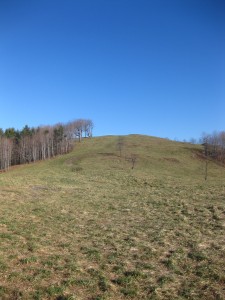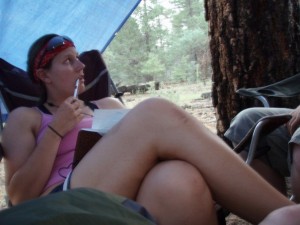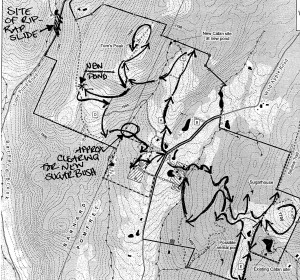Volunteer Monitoring 101: Lesson Three – If You’re not Sure, Don’t Make It Up
Lesson Three – If You’re not Sure, Don’t Make It Up
Background Reading
Sometimes the easiest thing to do is agree with someone. Many people do not like confrontation, whether it harkens back to the bully from elementary school, roommates who use your stuff, or that shopper at the grocery store who just can’t understand why parking at a 45 degree angle across three spaces is, in fact, the opposite of sharing.
For me, stepping in to straighten out situations like these doesn’t do much to perturb me. Instead, my confrontation anxiety shows itself most under the focused attention that comes when someone puts me on the spot. This is, I am told, a common side effect to having a shy nature.
The confrontation usually goes down something like this:
The formula: “Hey Anna, you (insert known fact about Anna here)! You must know all about x, y, & z!â€
Internal Response: Oh geez
External Response: “Oh, sure, yep.â€
Example:
Expectantly-hopeful-acquaintance – “Hey Anna, you grew up in Vermont! You must know my in-laws, they vacation in this little town, you know it’s up there near Canada, maybe it was Woodstock!?â€
Oh geez
On-the-spot Anna – “Oh, um, maybe. I grew up near Montpelier….uh, you know Woodstock isn’t really near Canada. At all.â€
This type of thing can go on all day! Including lengthy explanations that while Vermont is small we residents may not have visited every town and probably do not know every single other person in the state.
In my experience it is easy for your brain to turn on you in these situations. Your brain knows that you do not have a clue what this person is talking about, however, in a desperate attempt to shift the focus elsewhere you just agree with the person. You find yourself smiling and nodding, “Yes, I know who/what you’re talking about! “ The entire time you are also squashing down the alarm that you may end up having to prove it.

Facing difficult questions can be a lot like hiking up bare & windy hills – excruciating at the time but worth putting in the effort.
Now needless to say this type of anxiety isn’t great in the professional world. I am happy to report that in a good 99% of paralyzing social situations of this nature I can handle with no trouble. A far cry from the years I hid my face while my family sang ‘Happy Birthday’ to me in the privacy of our home because I didn’t like the attention. In fact, when I moved back to Vermont after years of living elsewhere I was even more comfortable saying, “Nope! I don’t know how to get there, know that person, or recognize anything you are saying because I’ve just moved back and I’m actually new (to this part of the State)!â€
Field Application & Case Study
So now that we have pinpointed that gut wrenching feeling behind this lesson we can ask the essential question: what about out in the field? Landowners, land caretakers, and even just folks you may meet along your trek as a volunteer monitor may have questions for you about UVLT and what you’re doing. It happens all the time, volunteers and co-workers trade stories about such things.
This weighed on my mind as I did my first solo monitoring visit at the beginning of December. The folks take good care of the property; they actively manage for several things including livestock pasture and a productive sugarbush. One of the land managers was my company for the day, and as a person who is in tune with the property he had plenty of questions and comments for me as we toured around. What did I think about this? Listen to these plans, how do they sound? And so on.
I began to realize that I was the ‘expert’ in this situation. I worked at UVLT and as the monitor for this year I was the nearest available authority on all things conservation related. So, this guy was focused on me to get all the answers!
Oh geez.
Thankfully, I did not panic! My strategy was to engage and listen, but not to advise. My response was often: “I can’t speak to that specifically, everything depends on your easement but I’d be happy speak to so-and-so back at the office about this. Then we’ll be in touch with you with answers.â€
At first he seemed a bit surprised that I wasn’t willing to elaborate, after all I worked for the Land Trust didn’t I? But, I stuck to my refrain and as the visit progressed he was able to discern that I wasn’t covering up a mental deficiency by not answering his questions but rather trying to ensure he’d get the correct answer and level of detail he was looking for. Ultimately, this was satisfactory to him without placing myself out on a limb by advising upon what I did not know – and we did get him answers to all of his questions soon after my visit.
Overall, my experience underscored the fact that our role as volunteer monitors is twofold; that of an observer and gatherer of data as well as being the face of an organization and ourselves. As monitors we must keep in mind that the property we are visiting has legal restrictions upon it and because of this we strive to provide clear and accurate answers to questions. You do have the powerful tool we learned about in Lesson One – the monitoring folder – with you on the visit but, though it contains information that may provide answers you should always verify with UVLT’s staff and let them give the final word.
In addition to these practical acts we must also remember that we not only represent ourselves as individuals but we also represent UVLT as an organization and even Land Conservation as a larger movement. When I made that first property visit, I had been a member of the Upper Valley community for a mere 6 months. Already I felt like I was surrounded by friends. I was meeting people and building relationships as an individual and a professional and of course I wanted to make a good impression but I didn’t risk providing wrong information just to do so. I had to be confident enough to say I didn’t know the answers.
We are, on a basic level, the eyes and ears of UVLT but in reality, we are much more than that. And I, for one, am glad to spend my time outside in such an endeavor even if I do fall under a scrutinizing gaze every now and again.
This is the second post of a series I am writing about my experience becoming a fully trained monitor for UVLT. If you missed the first one you can read it here. I came to the Land Trust with some field experience but I knew it was unlikely that the methods I had been taught would be an exact fit for UVLT’s stewardship needs – and boy was I right! I hope you will enjoy learning, laughing, and pondering with me as I collect and nurture the knowledge, skills, and abilities gained from spending time outside.
Anna Slack, UVLT Programs Coordinator, Monitor-in-Training
** If you’re interested in becoming a monitor yourself contact us! **



